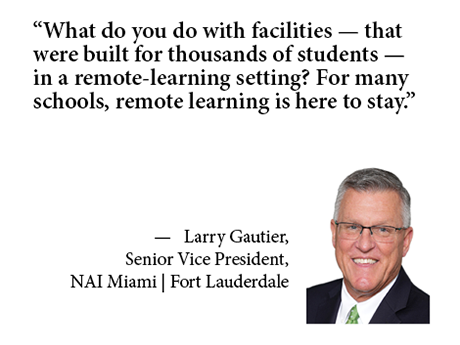The term “adaptive reuse” in real estate circles typically conjures images of repurposing old, obsolete commercial buildings. Meanwhile, academic buildings, administrative offices and other properties on college campuses rarely come to mind.
But NAI has noted a growing need among higher learning institutions with vacant or underused assets, particularly as a result of growing online learning options, says Larry Gautier, senior vice president of NAI Miami | Fort Lauderdale. As a result, the brokerage is focused on finding solutions for schools.
“NAI hasn’t historically been involved with higher institutions of learning — we’ve typically focused on conventional real estate transactions,” Gautier acknowledges. “But a few years ago, when students weren’t going in to class, colleges and universities were facing a challenge: what do you do with facilities — that were built for thousands of students — in a remote-learning setting? For many schools, remote learning is here to stay.”
Options include leasing buildings to commercial users or entering a joint venture with, for example, an aerospace or engineering company for educational programs, he adds. Colleges that suddenly have vast unused parking lots could also enter into long-term leases with multifamily, office or mixed-use developers.
“Our position is to help these schools create a strategy — what do you keep, what do you let go, what do you fix — and then implement that strategy,” Gautier explains. “There are three factors important to colleges: revenue, how the property contributes to the student experience and whether it engages the community in some way.”
Soccer and Pickleball
NAI Miami | Fort Lauderdale initiated this service at Broward College in Fort Lauderdale. The school’s board of trustees decided to drop athletics from the school’s programs after the pandemic lockdowns ushered in a high rate of online learning, Gautier says. Consequently, a number of facilities became surplus, and Gautier sought to readapt the facilities to serve the school’s needs.
In this particular case, the school was searching for a way to generate revenue. As the number of students using remote learning grew, the state reduced funding tied to the use of facilities, he recalls. Seeing an opportunity to bring in outside users, Gautier arranged for a soccer academy to lease its soccer field and facilities on Broward College’s south campus. He also signed a pickleball operator to create a complex in a vacant gym on the north campus.
The gross value of the deals is more than $3 million over the 10-year term of the lease, and the college was able to secure certain days and times for students to use the recreational facilities, he says. That deal worked well largely because the properties were on the fringe of the campus. “If you’re in the core,” Gautier remarks, “it can sometimes be a more difficult problem to solve given security considerations and other issues that crop up when sharing spaces with students.”
Mergers and Growth
In another instance, Notre Dame of Maryland University recently announced that it would acquire Maryland University of Integrative Health (MUIH), and MUIH’s has hired NAI KLNB in Columbia, Maryland, to sell its 12-acre campus. The property includes a 32,488 square feet office and classroom building, parking and vacant ground zoned as a planned employment center.

“Since the pandemic, all but one program being offered there can be done online,” says Abby Glassberg, a principal with NAI KLNB who is marketing the campus.
Not all schools are looking for ways to reduce or reuse their properties, however. Many community colleges in Glassberg’s region are growing as the price to attend four-year universities continues to escalate, she notes. Those schools suddenly need additional space and are looking at leasing offices. Glassberg recently arranged a 48,871-square-foot lease in an office building for Prince George’s Community College to serve students off the main campus.
“These community colleges are really picking up the slack in terms of enrollment, but they can only put so much density on their campuses,” Glassberg says. “While office space here might not be as soft as other parts of the country (because of a lot of government and defense demand), there is some softening. That’s providing these community colleges with opportunities to take more space.”
— By Joe Gose. This article was written in conjunction with NAI Global, a content partner of REBusinessOnline. For more articles from and news about NAI Global, click here.


